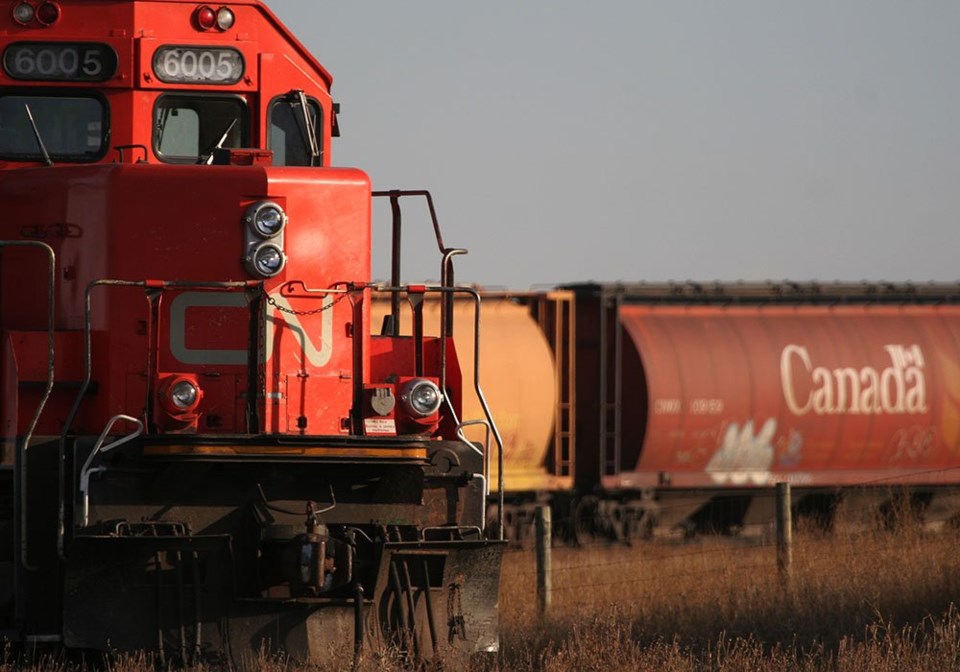WESTERN PRODUCER — Canadian National Railway says it will be able to move the anticipated volumes of grain in 2022-23 but warned there will be times in the fall and winter when demand exceeds capacity.
“We are positioned well here and we’re confident that we’re in good shape to move the anticipated volumes,” said David Przednowek, assistant vice-president of grain at CN.
Canadian Pacific Railway had not filed its annual grain plan in time to meet The Western Producer’s publication deadlines but a company spokesperson provided a similar outlook.
“CP is once again well-positioned to meet the transportation needs of our grain customers and the broader Canadian economy during the upcoming 2022-23 crop year,” Salem Woodrow said in an email.
CN plans to move 24.5 to 27 million tonnes of grain in bulk to port position but that number could go up if the crop is larger than anticipated.
The estimated volume would be well above the 18.2 million tonnes expected to be shipped in 2021-22 but way below the 29.9 million tonnes transported the previous year.
In its 2022-23 grain plan, the company warned there will be times when the railway won’t be able to keep up with the anticipated weekly demand from the grain sector.
“CN expects that total demand for rail capacity between Edmonton and the ports of Vancouver and Prince Rupert will exceed network capacity during some weeks in the fall of 2022 and in early 2023,” it said.
Wade Sobkowich, executive director of the Western Grain Elevator Association, got a bad vibe after his first cursory glance at CN’s plan.
“The first sections talk about reasons why CN probably won’t hit this plan and that is concerning,” he said.
Those sections referred to wildfires, flooding, COVID and other outside factors that can limit grain movement.
Przednowek stressed that this is going to be a year where grain companies need to make better use of the underutilized rail capacity in Eastern Canada.
“We want to have improved corridor balance across trade flows to get all that grain to market,” he said.
That means using Thunder Bay to the maximum extent possible in the fall when the St. Lawrence Seaway is open and directing more grain to ports in Montreal, Quebec City and Trois-Rivieres in the winter.
Sobkowich said that is not reasonable.
“As an essential service provider, it is incumbent on the railways to figure out how to meet our requirements, not the other way around,” he said.
“It would be equivalent to a telephone company saying its network can’t accommodate all the calls we’re making and it has noticed that evening capacity is wide open, so we should be making more calls at night even though our business hours are nine-to-five.”
CN said its maximum capacity is 36 million tonnes of bulk grain. That is based on the railway moving 7,800 rail cars per week of bulk and processed grain products outside of the winter months and 6,250 during winter.
Those volumes can only be obtained with perfect corridor balance, no significant labour disruptions, normal winter operating conditions and other factors.
Sobkowich said those maximum capacity numbers are essentially useless.
“We know we likely aren’t going to get that, so it’s almost meaningless information,” he said.
“It would be much better if CN could just produce a number saying this is how much we’re going to do.”
CN said overall demand for rail service has been wildly unpredictable in the past few years. It plummeted during COVID-19 and is now booming due to the war in Ukraine and sanctions imposed on Russia.
The conflict has resulted in high prices for grain, fertilizer, coal and energy products, incentivizing increased exports of all those commodities.
“However, rail capacity cannot quickly adjust to demand shocks driven by sudden changes in market conditions or significant global events,” the company stated in its annual plan.
CN says long lead times are required to recruit and train crews, acquire locomotives or rail cars and invest in track and other infrastructure to meet increased customer demand.
It typically takes six to nine months to recruit and train conductors.
“We have been aggressively recruiting people to become qualified conductors but CN has not been able to hire as many people as we wanted,” the company stated.
“Unemployment levels are at five-decade lows and demand for employees with the skill set CN needs is very high in many sectors of the economy.”
Przednowek said CN has hired 850 people since the end of 2021 and most of those new hires are conductors.
The company also recently acquired 57 high-horsepower locomotives and will be adding 500 new hopper cars to its fleet in 2022-23.




